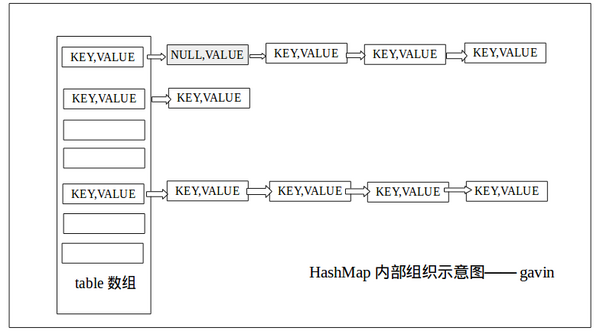引言
HashMap在键值对存储中被经常使用,那么它到底是如何实现键值存储的呢?
一 Entry
Entry是Map接口中的一个内部接口,它是实现键值对存储关键。在HashMap中,有Entry的实现类,叫做Entry。Entry类很简单,里面包含key,value,由外部引入的hash,还有指向下一个Entry对象的引用,和数据结构中学的链表中的note节点很类似。
Entry类的属性和构造函数:
final K key;
V value;
Entry<K,V> next;int hash;/**
* Creates new entry.
*/Entry(int h, K k, V v, Entry<K,V> n) { value = v;
next = n;
key = k;
hash = h;
}二 HashMap的初始化
//HashMap构造方法public HashMap(int initialCapacity, float loadFactor) { if (initialCapacity < 0) throw new IllegalArgumentException("Illegal initial capacity: " +
initialCapacity); if (initialCapacity > MAXIMUM_CAPACITY)
initialCapacity = MAXIMUM_CAPACITY; if (loadFactor <= 0 || Float.isNaN(loadFactor)) throw new IllegalArgumentException("Illegal load factor: " +
loadFactor); this.loadFactor = loadFactor;
threshold = initialCapacity;
init();
}这是HashMap的构造函数之一,其他构造函数都引用这个构造函数进行初始化。参数InitialCapacity指的是HashMap中table数组最初的大小,参数loadFactory指的是HashMap可容纳键值对与数组长度的比值(举个例子:数组长度默认值为16,loadFactory默认值为0.75,如果HashMap中存储的键值对即Entry多于12,则会进行扩容,扩容后大小为当前数组长度的2倍)。在构造函数中不会对数组进行初始化,只有在put等操作方法内会进行判断是否要初始化或扩容。
三 table数组
在HashMap中有一个概念叫做threshold(实际可容纳量),实际可容纳量指的是在HashMap中允许存在最多的Entry的个数,它是由HashMap中内置的数组table的长度*load factory(负载因子)得来。其作用是保证HashMap的效率。
table数组是HashMap实现键值对存储的又一关键,具体键值对是怎么存的呢?请看下图
如图中的[key,value]就是Entry对象来实现的,而table数组是用来存放Entry对象的。
//数组的初始化:private static int roundUpToPowerOf2(int number) { return number >= MAXIMUM_CAPACITY
? MAXIMUM_CAPACITY
: (number > 1) ? Integer.highestOneBit((number - 1) << 1) : 1;
}private void inflateTable(int toSize) { // Find a power of 2 >= toSize
int capacity = roundUpToPowerOf2(toSize);
threshold = (int) Math.min(capacity * loadFactor, MAXIMUM_CAPACITY + 1);
table = new Entry[capacity];
initHashSeedAsNeeded(capacity);
}在put等方法中发现数组未进行初始化时会调用InflateTable方法进行初始化,输入参数为初始设置的InitialCapacity,实际上他会调用roundUpToPowerOf2方法返回一个比初始容量大的最小的2的幂数(其中一个原因是在得到Entry所在数组位置时方便)。
四 put方法
public V put(K key, V value) { if (table == EMPTY_TABLE) {
inflateTable(threshold);
} if (key == null) return putForNullKey(value); int hash = hash(key); int i = indexFor(hash, table.length); for (Entry<K,V> e = table[i]; e != null; e = e.next) {
Object k; if (e.hash == hash && ((k = e.key) == key || key.equals(k))) {
V oldValue = e.value;
e.value = value;
e.recordAccess(this); return oldValue;
}
}
modCount++;
addEntry(hash, key, value, i); return null;
}private V putForNullKey(V value) { for (Entry<K,V> e = table[0]; e != null; e = e.next) { if (e.key == null) {
V oldValue = e.value;
e.value = value;
e.recordAccess(this); return oldValue;
}
}
modCount++;
addEntry(0, null, value, 0); return null;
}void addEntry(int hash, K key, V value, int bucketIndex) { if ((size >= threshold) && (null != table[bucketIndex])) {
resize(2 * table.length);
hash = (null != key) ? hash(key) : 0;
bucketIndex = indexFor(hash, table.length);
}
createEntry(hash, key, value, bucketIndex);
}void createEntry(int hash, K key, V value, int bucketIndex) {
Entry<K,V> e = table[bucketIndex];
table[bucketIndex] = new Entry<>(hash, key, value, e);
size++;
}在put方法中
1. 首先会判断数组是否为空,如果为空会对数组进行初始化。
2. 接下来判断key是否为null,如果为null就采用第二个方法对键值对进行put。
3. 接下来对key进行hash得到一个数值,再对这个数值进行处理(IndexFor方法)得到所在数组中的位置。
4. 接下来会遍历所在数组位置的链表,如果key的hash和传入key的hash相同且(key内存地址相等 或 equals方法相等),则意味着会更新在链表中的value值,并返回旧的value值。
5. 如果上边的方法都没有奏效,则会调用第三个方法,创建一个新的Entry对象。
在putForNullKey方法中 ,我们看到它是为了NULL值专门设置的,NULL值的hash始终为0,所以key为NULL的Entry对象肯定在数组的第0个位置。同样,如果找到则更新,没有找到则添加。
调用addEntry方法 意味着要往这个数组链表中添加一个Entry,所以会在最开始判断已经存在的Entry数量是否超过了实际可容纳量。如果超过了,则会调用resize方法将数组扩大两倍,注意在扩大之后会对已经存入的Entry进行重排,原因是当初存入时IndexFor方法与数组长度有关系。接着会调用第四个方法。
createEntry方法 很简单,就是将原本在数组中存放的链表头置入到新的Entry之后,将新的Entry放入数组中。从这里我们可以看出HashMap不保证顺序问题。
get方法和contains方法原理和put方法一致,即先通过对key的hash得到其value值所在的链表头在数组中的位置,再通过equals方法判断value是否存在。
五 其他
//hash方法final int hash(Object k) { int h = hashSeed; if (0 != h && k instanceof String) { return sun.misc.Hashing.stringHash32((String) k);
}
h ^= k.hashCode(); // This function ensures that hashCodes that differ only by
// constant multiples at each bit position have a bounded
// number of collisions (approximately 8 at default load factor).
h ^= (h >>> 20) ^ (h >>> 12); return h ^ (h >>> 7) ^ (h >>> 4);
}hash方法中最终返回值与key的hashCode方法有关。
总结
最终数组初始化的容量大小会是大于等于你传入初始容量的最小2的幂数。
key为null或value为null能存入HashMap的原因是对null值会进行单独的操作。
在table数组中的链表中每个Entry的共同点是key的hash(key.hashCode)部分相同。
注意对key的hashCode和equals方法的重写当你想让两个key映射一个对象,因为判定key相等的条件是(hashCode相等+(内存相等 或 equals相等))。
最早存入的键值对会在链表的末端。
当数组没有链表存在时,HashMap性能最好为O(1)。而最差为O(threshould)。
共同学习,写下你的评论
评论加载中...
作者其他优质文章





